
|
 |

|
 |
Brahmanical interventions in Kerala's musical legacy - V. Kaladharan e-mail: kaladh@rediffmail.com April 17, 2024 I have often wondered what prevented Kerala, the south-west tip of the Indian sub-continent, from embracing the oceanic grandeur and profundity of the classical Karnatic music till the dawn of the 20th century. King Swathy Thirunal and his court musicians definitely did have an influence in Thiruvananthapuram and in its immediate precincts in the 19th century when it comes to Karnatic music. The untimely demise of Swathy sounded the death knell of Karnatic music too in the capital city of the erstwhile Travancore. This was but an ephemeral state of affairs. 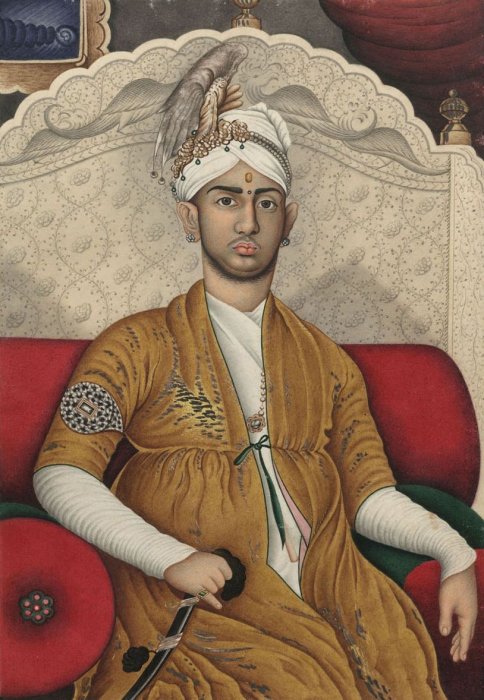 Swathy Thirunal The arrival of Harikesanalloor Muthiah Bhagavathar and Semmangudi Srinivasa Iyer, after an interlude, at the invitation of the royal family of Travancore proved to be instrumental in institutionalizing Karnatic classical music in Kerala. The Music Academy galvanized by them in 1939 was renamed as Swathy Thirunal Music College in 1962. When Semmangudi re-composed the music of the Swathy Kruthi, Bhavayami raghuramam in ragamalika evocatively sung by none other than M.S.Subbulakshmi, it became, for the middle class music lovers, a window to the world of Karnatic music. Here a pertinent question arises. What about the magnificent lineage of musicians hailing from East Palakkad who must have upheld the heritage of Karnatic music even in the pre-Swathy period? In fact, as far as music is concerned, East Palakkad has ever been embedded in and indebted to the mainstream music culture of Chennai. Kalpathi, Noorani and Manjapra villages, although technically part and parcel of Kerala, have always had a distinct cultural template. Here I am not specifically dealing with the historical reasons for the same as it is outside the purview of the topic, I want to zero in on to. 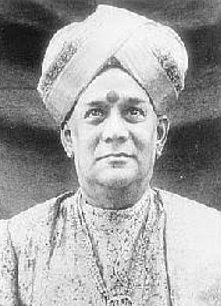 Muthiah Bhagavathar  Semmangudi Srinivasa Iyer Dominance of rituals The Brahmins in Kerala generally referred to as Namboodiris, as evident from history, held hegemony over its cultivable lands along the coastal belt for centuries. Through Devaswom (land owned by the temple) and Brahmaswam (land owned by the Brahmins), they ruled over the most fertile lands in north and central Kerala. During a detailed conversation I had with the late Killimangalam Vasudevan Namboodiripad, an art scholar and a pro left thinker, decades back, he specified in unequivocal terms the reason why Kerala became impoverished in its vocal music heritage. "The Namboodiris in Kerala were obsessed with temple related rituals to such an extent that they successfully bracketed all our art forms with rituals. They preferred the signs and the symbols associated with rituals to the emotionally vibrant music that swept the whole of south India as part of the Bhakti Movement". In the same breath, he added that a Sanskrit theatre tradition like Kutiyattam dating back to 10th century AD survived in Kerala against all the odds solely because the Namboodiris tagged it to the rituals. Percussion music concert 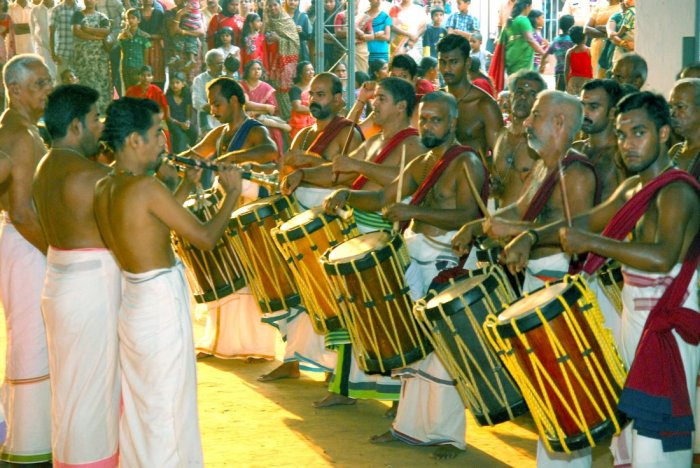 Melam, a collective ensemble with chenda as the major percussion instrument Photo credit: Sukumar C.V. Kottakkal Parallel to or as a rejoinder to the classical Karnatic music recitals spread over south India, the temple castes, Poduwals and Marars in central Kerala, composed percussion music concerts viz. Melam, an unbelievably huge ensemble comprising of different musical instruments spearheaded by chenda, Thayambaka, a solo recital on the chenda lifting the high-sounding drum to the zenith of creativity and Panchavadyam, the traditional temple orchestra, characterized by an interplay of five musical instruments, percussion and wind. The patronization for the various genres of percussion music came from the highly privileged Namboodiris under whom the artists cum temple servants had a hand to mouth existence. K.C. Narayanan, a renowned writer and an avid observer of Kerala's artistic heritage is of the view that the art lovers in Kerala are worshippers of "noise" instead of "voice". The unmistakable stamp of all the aforementioned three genres of percussion music is "loudness". With these three genres of music in mind, the Namboodiris in central Kerala conceptualized and perpetuated an artistic identity exclusive to the communities living in this land. The caparisoned elephants who lined up in front of the percussion ensembles in the major temple festivals, in a sense, substantiated the assertion of "artistic identity". 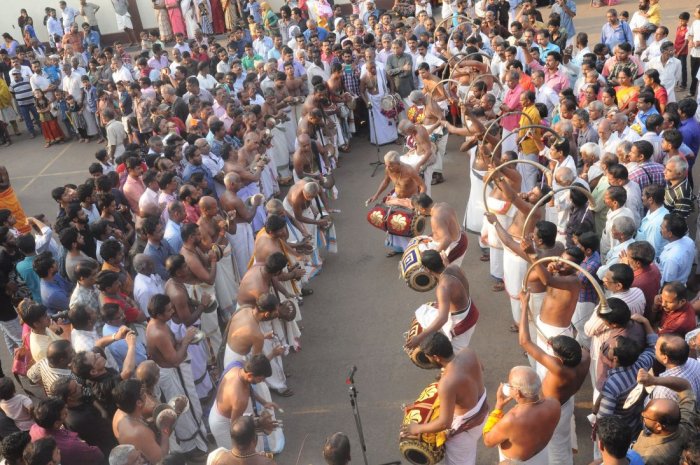 Panchavadyam, the traditional temple orchestra Photo credit: Sukumar C.V. Kottakkal Of the three genres, Melam has been consistently preserved as part of the temple worship tradition sans any major ups and downs. Panchavadyam, on the other hand, underwent tremendous transformations in the early 20th century. The architect of the modern Panchavadyam is ironically a Tamil Brahmin, Thiruvilwamala Venkichan Swami. From its primordial tala structure of 56 beats, Swami stretched it to the slowest tempo of 1792 beats. As the tempo rises, the time beats get reduced until it reaches 7 and further down to 3 and a half. This revolutionary reform redefined the scope and significance of Panchavadyam. Swami made it possible with the creative support and cooperation of the Thimila (the principal percussion instrument in Panchavadyam) maestros of his time. One of the most alluring features of the present day Panchavadyam is Thaniyavarthanam, a segment which Swami incorporated by gathering influence from the classical Karnatic music recital. 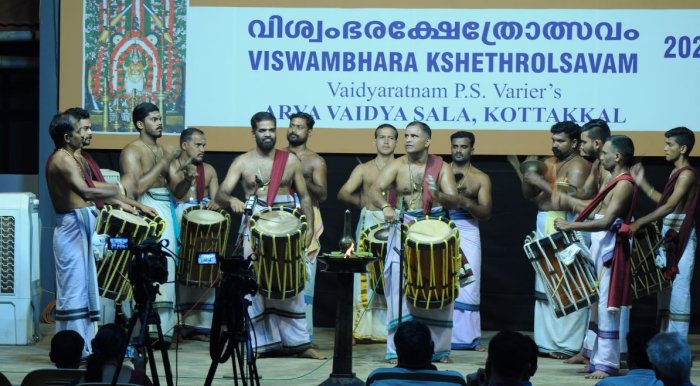 Thayambaka, a solo recital on the chenda Photo credit: Sukumar C.V. Kottakkal Thayambaka is a highly individualistic performance on the chenda. Of the stalwarts in the field, it is interesting to note that the late Thiruvilwamala Adantha Kontha Swamy enjoyed a pride of place. His playing of the highly innovative segment, "Adantha kooru", had had no parallels during his time or afterwards in Thayambaka. Of the two dominant schools of Thayambaka, the one that originated and prospered in the eastern part of Palakkad owes tremendously to the discourses on the mridangam in Karnatic music and Thavil in the Nagaswara concerts. If you take a look at the globally renowned art form called Kathakali there is no way you can underestimate its vocal music. Till the early decades of the 20th century, the vocal music of Kathakali which is technically the vachikabhinaya (verbal acting) of the actor was akin to Sopana sangeetam which is literally the singing of Gita Govinda or similar thyanis by a Marar/Poduwal standing beside the sanctum-sanctorum of the temple during poojas offered to the deity. Again, by the beginning of the 20th century, it was left to the task of Mundaya Venkitakrishna Bhagavathar and his brother Rama Bhagavathar to streamline the slokams and the padams of all the extant Kathakali plays with their practical knowledge of classical Karnatic music. Venkitakrishna Bhagavathar, the Tamil Brahmin vocalist, was conversant with the visual grammar of Kathakali too which helped him in no small measure to reframe the raga, tala and kala (tempo) treatments in accordance with the text and the contextual confederations. When poet laureate Vallathol Narayana Menon instituted Kerala Kalamandalam in 1930, Venkichan Swami was the Acharya for the two major percussion instruments in Kathakali - chenda and the maddalam. Swami was truly a multifaceted genius. 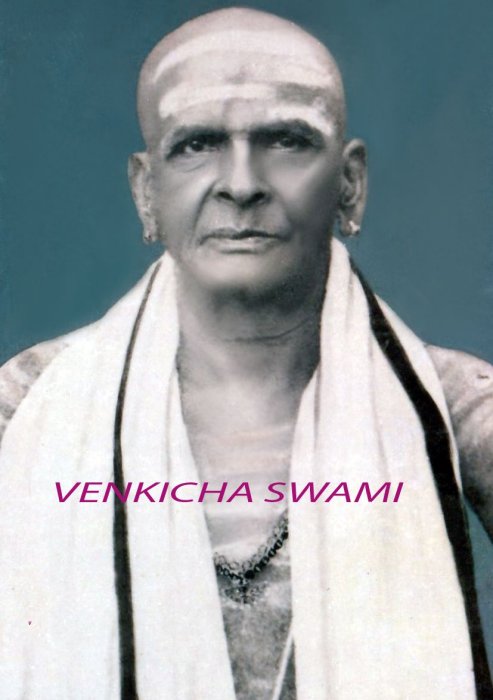 Venkichan Swami 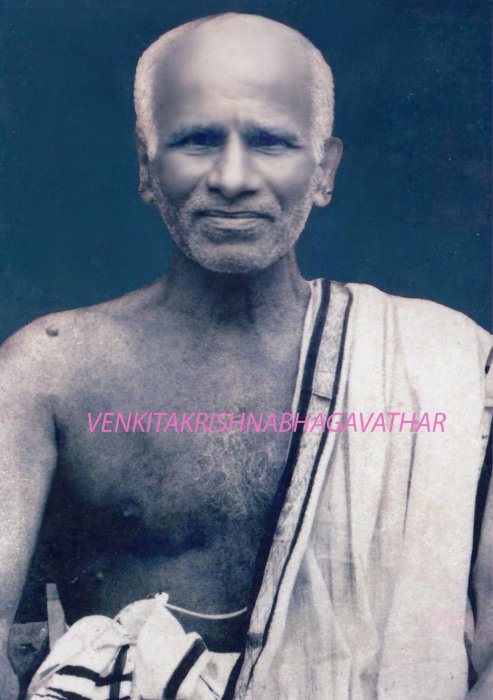 Venkitakrishna Bhagavathar The top-ranking Kathakali playwright, Kottayath Thampuran, prescribed the Vandana shloka penned by himself to be sung customarily as a prelude to any overnight Kathakali performance. Even today, all the Kathakali performances invariably begin with the shloka, Mathangaananam abjavasaramanim govindamadyam guru. The very first line of the shloka in raga Kedaragaula, seeks the blessings of Govinda along with Lord Ganesha and goddess Saraswathy. Here the term Govinda is specifically associated with the Guru of the playwright, Mayavaram Govinda Deekshithar, again a Tamil Brahmin. I have cited these instances to underscore the extent of influence exerted by the Tamil Brahmins either directly or indirectly in the art forms claimed to be an exclusive prerogative of the Malayalees. Politicization The leftist intellectuals and idealogues from the 1960's till 1980's had no hesitation in dismissing the highly evolved art forms of Kerala either as feudal relics or those aimed at the reinforcement of redundant values. While dissecting the political and aesthetic visions of Bertolt Brecht, poet and leftist thinker, K. Satchidanandan, emphatically cites Kathakali as a frozen discourse almost always offering the public the routine stuff. The birds of the same feather had vied with one another in denigrating Kathakali and similar art forms as much as they could. But in course of time, they realized that annihilating these art forms through uninterrupted diatribes is a formidable challenge as the renovation of the ruined temples together with the revamping of the festivities in the 1980's was complemented by countless opportunities for the visibility of the traditional performing arts. Sooner or later, they started noticing the fact that the classical Karnatic music was, either directly or indirectly through the film and the devotional music, exerting overwhelming influence amongst the public. The television channels too had risen to the occasion. In comparison to the mesmerizing impact of music, the influence of Kathakali and similar literature based art forms among the masses is rather moderate. The TV channels have also strong reservations about providing adequate exposure to these performing arts. Therefore the "cultural think-tanks" in the Kerala society directed their attention to the multiple streams of music. For them, music as such has never been a serious concern. Instead, they expended their time and energy for generating political readings from the various genres of music. More than a decade back, I had been to Udupi to attend a conference on traditional theater in which Dr. U.R. Ananthamoorthy was delivering the key-note address. During tea break, I asked Dr. Moorthy about his next visit to Kerala. He smiled and replied. "Everything is politicized in Kerala. It is an unfortunate predicament. I don't feel like returning to your home state which was once my preferred destination". His reaction didn't surprise me at all. The cultural climate of Kerala, which I have been witness to and participant of, has undergone unanticipated changes over the years. Each and every component, be it social, cultural, economic or religious, in my State is unfortunately politically polluted. Discreditation of literature and devotion Kerala has, over a quarter century, been the headquarters of pseudo-secularists and anti-Hindu intellectuals. Their ultimate goal is to devastate the citadels of Indian spiritualism for which, through their followers and fellow travelers, spadework has already started at the grassroot level viz. hijacking the Hindu temple administration, misinterpreting / over-interpreting the philosophy of the social reformer Sreenarayanaguru, portraying Kerala's eminent poet Kumaranasan as a hardcore leftist so on and so forth. In their discourses they spare no efforts to underplay the theism of these pre-eminent figures. Let me now return to the topic under discussion. The self-styled radical reformists and the intelligentsia, with the support of their cultural comrades in other States, have been contributing their mite for segregating the lyrics of the celebrated Vaggeyakaras from the ragas. For them, Swathy Thirunal is a tiny fish. Their target is the Trinity, the whales, as well as those distinguished Vaggeyakaras in the pre and the post Trinity periods. Their dream is to wipe out the predominance of the Vaggeyakaras from the annals of our cultural history. They want to erase from the cultural memory of south India the tangible and intangible assets associated with Bhakti, to be more precise, the nomenclatures and motifs such as Vinayaka, Siva, Uma, Srirama, Srikrishna, Karthikeya, Anjaneya and the like side by side with the state of bliss a devotee experiences while reciting / chanting / singing the hymns. Kritis and Keerthanas carry religious undertones and overtones the meanings of which are, to the radical minds, preposterous while the ragas in isolation are secular. In short, they are dreaming of reconstructing the south Indian world of music in such a way that the ragas and the swaras (chitta & kalpana) are well preserved as "secular treasures" while the literature embodying Bhakti and Dharma are something to be done away with at any cost. The same logic is applied to the globally hailed performing arts of Kerala as well. Their argument is that the text of the plays of Kathakali and Kutiyattam is merely a fragile backdrop for the actors to present their prowess in angika and satwikaabhinyas. In other words, the text, the contexts and the characters are subservient to the "techniques" that encapsulate the entire gamut of the movement vocabulary and rasabhinaya (emotive acting). If so, the time honored plays cease to be indispensable to the performance; Plays having progressive content or political messages or slogans can easily be substituted for the traditional plays. I am pretty much sure that on completion of their ongoing tasks associated with the obliteration of the historical glory of classical Karnatic music, the firebrand idealogues and their henchmen here would make every effort to deconstruct Kerala's traditional performing arts and would evolve strategies to eradicate the Brahminical influences step by step or at a stretch. Kerala, literally, "the land of coconut trees", has mainly through the literati, been breeding a counterculture hell bent on demolishing the pillars of its artistic heritage, ritualistic resources and aesthetic nuances through multiple strategies. I don't know yet who invented the catchy adage "Kerala, God's own country". Maybe an innocent western tourist haunted by the lush green trees, flower laden plants and the breezy paddy fields of Kumarakam, our all too familiar tourist hub. What an adorable, unquestionable maxim! If one goes beyond this bewitching byword with an irresistible quest, he/she is sure to confront dark clouds looming over the entire Kerala society. What concerns me and the like-minded is that these are not evanescent but instead enduring. (All views, thoughts and opinions expressed in this article are solely of the author.) 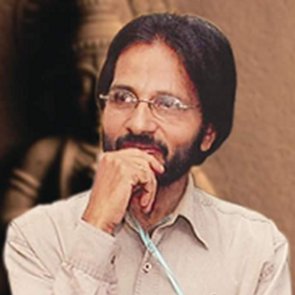 Former Deputy Registrar of Kerala Kalamandalam, V Kaladharan is also an art critic. He has published several articles at the academic level. 'From Meditative Learning to Impersonal Pedagogy' was published in an anthology 'Qui Parley' initiated and released by scholars and writers from the University of California, Berkeley. His articles on Indian performing arts and literature regularly appear in magazines and journals, and in the Friday Page of The Hindu. Response * Among all that has been mentioned, I concur to the thoughts with sadness that the Parasurama Kshetra and the deep rooted Hindu customs, rituals and many other related fronts has been politicised, twisted and distorted beyond repair. Like your friend/colleague whom you met at Udupi, no one would want to return to the state willingly seeing its plight in the past few years. - Maheshwaran Thekkemadom (Oct 14, 2025) Post your comments Pl provide your name and email id along with your comment. All appropriate comments posted with name & email id in the blog will also be featured in the site. |